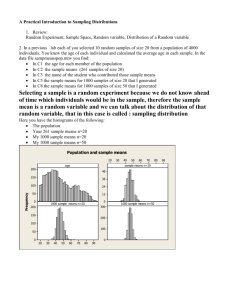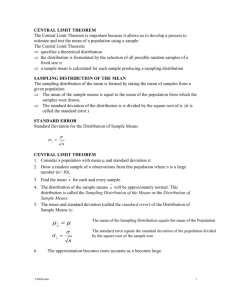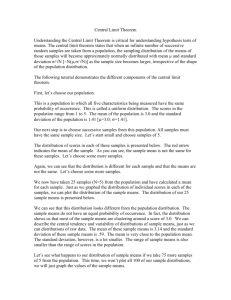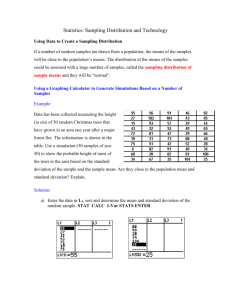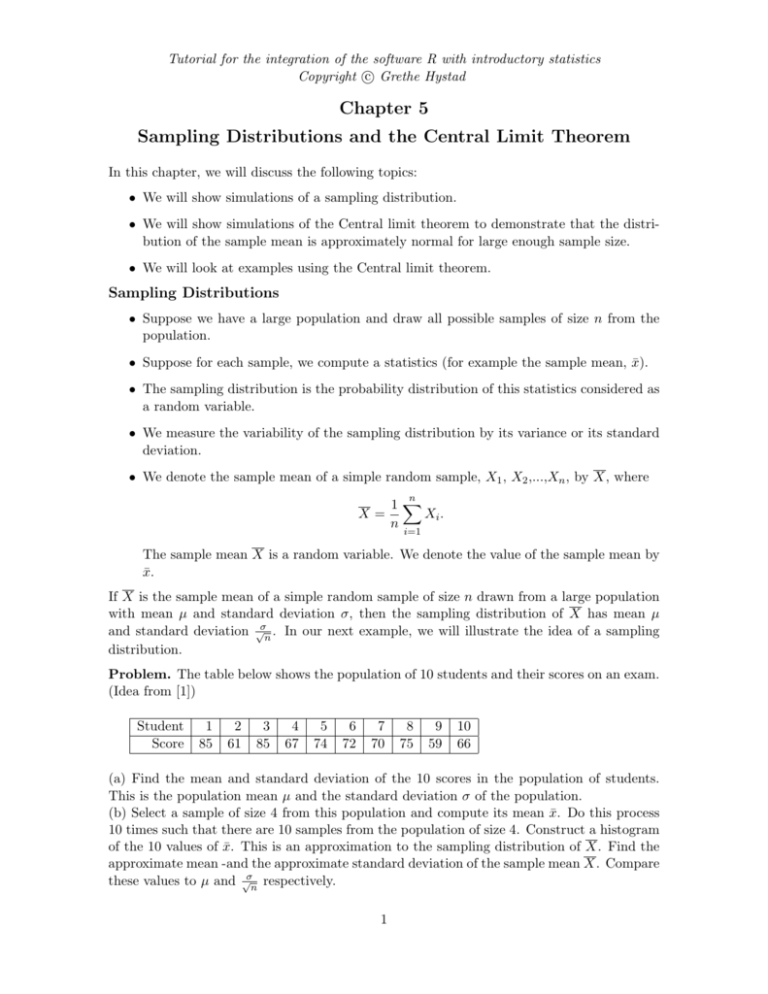
Tutorial for the integration of the software R with introductory statistics
c Grethe Hystad
Copyright Chapter 5
Sampling Distributions and the Central Limit Theorem
In this chapter, we will discuss the following topics:
• We will show simulations of a sampling distribution.
• We will show simulations of the Central limit theorem to demonstrate that the distribution of the sample mean is approximately normal for large enough sample size.
• We will look at examples using the Central limit theorem.
Sampling Distributions
• Suppose we have a large population and draw all possible samples of size n from the
population.
• Suppose for each sample, we compute a statistics (for example the sample mean, x̄).
• The sampling distribution is the probability distribution of this statistics considered as
a random variable.
• We measure the variability of the sampling distribution by its variance or its standard
deviation.
• We denote the sample mean of a simple random sample, X1 , X2 ,...,Xn , by X, where
n
1X
Xi .
X=
n
i=1
The sample mean X is a random variable. We denote the value of the sample mean by
x̄.
If X is the sample mean of a simple random sample of size n drawn from a large population
with mean µ and standard deviation σ, then the sampling distribution of X has mean µ
and standard deviation √σn . In our next example, we will illustrate the idea of a sampling
distribution.
Problem. The table below shows the population of 10 students and their scores on an exam.
(Idea from [1])
Student
Score
1
85
2
61
3
85
4
67
5
74
6
72
7
70
8
75
9
59
10
66
(a) Find the mean and standard deviation of the 10 scores in the population of students.
This is the population mean µ and the standard deviation σ of the population.
(b) Select a sample of size 4 from this population and compute its mean x̄. Do this process
10 times such that there are 10 samples from the population of size 4. Construct a histogram
of the 10 values of x̄. This is an approximation to the sampling distribution of X. Find the
approximate mean -and the approximate standard deviation of the sample mean X. Compare
these values to µ and √σn respectively.
1
Solution to part (a). We obtain:
> Score=c(85,61,85,67,74,72,70,75,59,66)
> mean(Score)
[1] 71.4
> sd(Score)
[1] 8.834277
Hence, µ = 71.4 and σ = 8.8343.
Solution to part (b). We obtain:
> MeanSRS=numeric(10)
> for (i in 1:10){SRS=sample(Score,4);MeanSRS[i]=mean(SRS)}
> hist(MeanSRS,col="yellow")
> MeanSRS
[1] 70.75 66.00 74.00 76.25 70.00 70.25 71.75 75.25 68.75 71.50
> mean(MeanSRS)
[1] 71.45
> sd(MeanSRS)
[1] 3.074989
> sd(Score)/sqrt(10)
[1] 2.793644
The approximate mean of X is 71.45 and the approximate standard deviation of X is 2.7936.
The true mean and standard deviation of the sample mean X is µ = 71.4 and √σ10 = 2.7937,
respectively.
Explanation. The code can be explained as follows:
• The command MeanSRS=numeric(10) initiates the vector variable we name MeanSRS with zero in each of its 10 entries.
• The command for (i in 1:10) returns a for loop over a list of 10 numbers.
2
• The body of the for loop, {SRS=sample(Score,4);MeanSRS[i]=mean(SRS)},
creates a simple random sample of size 4 drawn from the population of Score in the
ith iteration. The mean of this sample is calculated and stored in MeanSRS. This
process is repeated 10 times.
• By typing MeanSRS we can observe the mean value of each of the 10 samples stored
in the vector MeanSRS.
• The remaining steps calculate the mean and standard deviation of the data in MeanSRS, and draws its histogram.
The Central Limit Theorem
Let X be the mean of a simple random sample, X1 , X2 ,..., Xn , of size n from a population
with mean µ and standard deviation σ. The Central limit theorem says that the sampling
distribution of the sample mean X is approximately Normal with mean µ and standard
deviation √σn for large enough sample size n.
When can we use the Central limit theorem? [2]
• The Normal distribution is a good approximation to the sampling distribution of the
mean when n is greater than 25 or 30.
• If the underlying distribution is continuous, symmetric and with only one peak, the
Normal approximation can be good for n as small as 4 or 5.
• If the underlying distribution is approximately normal, then the distribution of X will
be approximately normal for n as small as 2 or 3.
Problem. Use R to simulate 1000 times the sampling distribution of the mean, X, of 1, 30,
and 1000 observations from the uniform distribution. Create a histogram and determine the
mean and standard deviation of these simulations.
Solution. We simulate for sample sizes 1, 30, and 1000, respectively:
> xbar=numeric(1000)
> for (i in 1:1000){x=runif(1);xbar[i]=mean(x)}
> hist(xbar,col="orange",main="n=1")
> mean(xbar)
[1] 0.4996082
> sd(xbar)
[1] 0.2887753
> xbar2=numeric(1000)
> for (i in 1:1000){x=runif(30);xbar2[i]=mean(x)}
> hist(xbar2,col="red",main="n=30")
> mean(xbar2)
[1] 0.5007057
> sd(xbar2)
[1] 0.05266257
3
> xbar3=numeric(1000)
> for (i in 1:1000){x=runif(1000);xbar3[i]=mean(x)}
> hist(xbar3,col="green",main="n=1000")
> mean(xbar3)
[1] 0.5000741
> sd(xbar3)
[1] 0.009484849
The uniform distribution
q on the interval from 0 to 1 has population mean µ = 0.5 and
1
standard deviation σ = 12
. When n = 1000, the distributional standard deviation of the
1
σ
= √12000
= 0.009128709. We see that the sample mean of the simulations
mean is √1000
approaches 0.5. The standard deviation of the mean from the simulations gets smaller as n
gets larger and is close to the distributional value when n = 1000. We can also see that as n
gets larger, the distribution of X approaches the normal distribution.
Explanation. The code can be explained as follows:
• The commands runif(1), runif(30), and runif(1000) draw random samples from the uniform distribution of sizes 1, 30, and 1000, respectively. (See the previous chapter). These
processes are repeated 1000 times.
4
Problem. Suppose a certain manufacturer produces steel shafts for which the diameter has
mean 0.3 inches and standard deviation 0.05 inches.
(a) Determine the mean and standard deviation of the average diameter of 30 shafts.
(b) Use the Central limit theorem to determine the probability that the average diameter of
30 shafts is greater than 0.31.
Solution to part (a). The mean of the average diameter of 30 shafts is 0.3 and the standard
0.05
deviation is √σn = √
= 0.0091287.
30
Solution to part (b). Let X1 ,..., X30 be the diameter of the 30 shafts. We want to find
P (X > 0.31), where X is approximately normally distributed with mean 0.3 and standard
deviation = 0.0091287 by the Central limit theorem. Using R:
> pnorm(0.31,0.3, 0.0091287,lower.tail=FALSE)
[1] 0.1366606
Thus, P (X > 0.31) = 0.137.
References
[1]
D. S. Moore, W. I. Notz, M. A. Fligner, R. Scoot Linder. The Basic Practice of Statistics.
W. F. Freeman and Company, New York, 2013.
[2]
E. A. Tanis, R. V. Hogg. A Brief Course in Mathematical Statistics. Pearson Prentice
Hall, Upper Saddle River, NJ, 2008.
00
5


